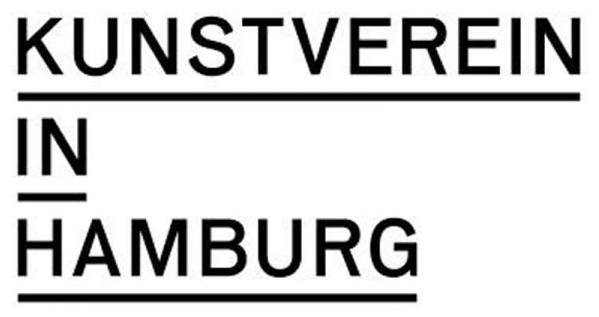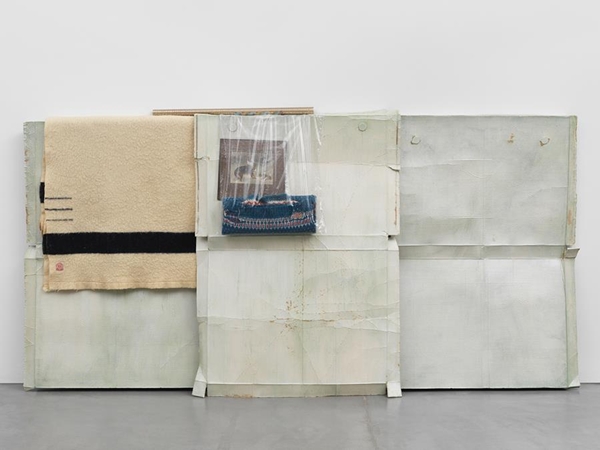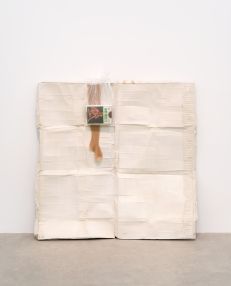"you you you"
Liz Magor
curated by Bettina Steinbrügge
presented by the gallery :

Andrew Kreps Gallery
537/535 W. 22ND ST. NEW YORK, NY 10011TEL 212 741 8849 FAX 212 741 8163 e-mail:

Kunstverein
Klosterwall 23 20095 HamburgT +49 40 32 21 57 F +49 40 32 21 59 email :
July 1 > 3 September, 2017
 Liz Magor, Good Shepherd, 2016, Polymerized gypsum, wool, plastic bags and sheet, cardboard. |
 Liz Magor, New Society, 2016, Courtesy of the artist and Catriona Jeffries, Vancouver. Photo: SITE Photography |
The Kunstverein in Hamburg presents the first German solo exhibition of the Canadian sculptor Liz Magor (*1948, Winnipeg, Canada, lives and works in Vancouver). During the course of her career spanning more than forty years, Magor, who ranks among Canada’s most influential artists, has repeatedly gauged the boundaries of what constitutes sculpture. Her works today play an important role in the international debate on materialism in contemporary sculpture. Magor takes common and familiar objects of our world and uses them in her installations either as ready-mades or replicates them with other materials. Transferring them to the context of art raises questions regarding the relationship between art and everyday life as well as between reality and representation. Through deliberately placed voids and mises-en-scène, Magor’s works develop a narrative potential comparable with the literary form of the short story—lacking a beginning and end, they are excerpts of an overarching narration of the social sideshows of our present-day achievement-oriented society. The show assembles sculptures and installations of the past three decades
Liz Magor is fascinated by the culture of production and value addition, by those consumer goods, to which people notably have an ambivalent relationship. She creates casts of different kinds of discarded and undervalued objects, from toys to cigarettes all the way to tree trunks, and combines them with found objects from the everyday world with the aim of prompting speculations about the loss of commercial appeal or the deceptive gloss of surfaces. The interplay of materials twists the values. The worn pieces from the flea market can hardly be distinguished from her sculptures, meaning that object and sculpture merge directly. Which one has which status? Or, as Beate Scheder stated it in the daily newspaper taz: “What possesses which value and why? What are things doing with us and we with them?”
By working in series and juxtaposing several casts of the same form, to then differentiate them again by adding mass-produced goods, the artist counters the present-day striving for individualism. She says: “So the horror of having an identity that is not unique is persistent and tightly woven into our manufacturing, economic and social ideas.“ The rediscovery of Liz Magor’s oeuvre in Europe correlates to a young generation of artists for whom the self-referentiality of materials and the efficacy of objects are crucial elements in their production of art. What is interesting about Liz Magor’s work in the context of the “material turn” is that she attributes a decisive role to the material world in the development of social structures. Her engagement with the most various materials, her idiosyncratic image language, her dispensing with all forms of pedestals, and the connection she makes between sculpture and space stand for a trend in sculpture, in which the viewers are constantly challenged with structuring their perception, comparing it with real life, and then dissolving it again through subjective forms of cognition.
Magor’s works have been shown in various solo exhibitions around the world, e.g. at Musée d'art contemporain de Montréal (2016), Centre d'art contemporain d'Ivry (le Crédac) in Paris (2016), the Art Gallery of Ontario (2015), Peep-Hole in Milan (2015), Presentation House Gallery in Vancouver (2014), the Henry Art Gallery in Seattle (2008) and The Power Plant in Toronto (2003). Liz Magor represented Canada at the Venice Biennale (1984), took part in documenta 8 in Kassel (1987) and participated in the Biennale of Sydney (1982).
The exhibition is curated by Bettina Steinbrügge and accompanied by a monographic publication.
The exhibition was conceived in collaboration with the Migros Museum für Gegenwartskunst in Zurich and realized in partnership with the Musée d’art contemporain de Montréal and the Contemporary Art Gallery, Vancouver. The exhibition will travel further to MAMAC - Musée d'Art Moderne et d'Art Contemporain de Nice. It is kindly supported by the Ministry of Culture and Media of the Free and Hanseatic City of Hamburg, the Federal Cultural Foundation and the Canada Council for the Arts.
Liz Magor is fascinated by the culture of production and value addition, by those consumer goods, to which people notably have an ambivalent relationship. She creates casts of different kinds of discarded and undervalued objects, from toys to cigarettes all the way to tree trunks, and combines them with found objects from the everyday world with the aim of prompting speculations about the loss of commercial appeal or the deceptive gloss of surfaces. The interplay of materials twists the values. The worn pieces from the flea market can hardly be distinguished from her sculptures, meaning that object and sculpture merge directly. Which one has which status? Or, as Beate Scheder stated it in the daily newspaper taz: “What possesses which value and why? What are things doing with us and we with them?”
By working in series and juxtaposing several casts of the same form, to then differentiate them again by adding mass-produced goods, the artist counters the present-day striving for individualism. She says: “So the horror of having an identity that is not unique is persistent and tightly woven into our manufacturing, economic and social ideas.“ The rediscovery of Liz Magor’s oeuvre in Europe correlates to a young generation of artists for whom the self-referentiality of materials and the efficacy of objects are crucial elements in their production of art. What is interesting about Liz Magor’s work in the context of the “material turn” is that she attributes a decisive role to the material world in the development of social structures. Her engagement with the most various materials, her idiosyncratic image language, her dispensing with all forms of pedestals, and the connection she makes between sculpture and space stand for a trend in sculpture, in which the viewers are constantly challenged with structuring their perception, comparing it with real life, and then dissolving it again through subjective forms of cognition.
Magor’s works have been shown in various solo exhibitions around the world, e.g. at Musée d'art contemporain de Montréal (2016), Centre d'art contemporain d'Ivry (le Crédac) in Paris (2016), the Art Gallery of Ontario (2015), Peep-Hole in Milan (2015), Presentation House Gallery in Vancouver (2014), the Henry Art Gallery in Seattle (2008) and The Power Plant in Toronto (2003). Liz Magor represented Canada at the Venice Biennale (1984), took part in documenta 8 in Kassel (1987) and participated in the Biennale of Sydney (1982).
The exhibition is curated by Bettina Steinbrügge and accompanied by a monographic publication.
The exhibition was conceived in collaboration with the Migros Museum für Gegenwartskunst in Zurich and realized in partnership with the Musée d’art contemporain de Montréal and the Contemporary Art Gallery, Vancouver. The exhibition will travel further to MAMAC - Musée d'Art Moderne et d'Art Contemporain de Nice. It is kindly supported by the Ministry of Culture and Media of the Free and Hanseatic City of Hamburg, the Federal Cultural Foundation and the Canada Council for the Arts.



Opening :
June 30, 7pm
mpefm
GERMANY art press release
open to the public :
Tuesday – Sunday and Public Holidays noon – 6 pm
Open on Good Friday, Easter Monday, May 1st, Whit Monday, Ascension Day, Feast of Corpus Christi, October 3rd, December 25th and 26th.
Closed on December 24th and 31st as well as January 1st.
ADMISSION
5,- Euro, reduced 3,- Euro
Groups of 10 or more: 3,- Euro, reduced 2,- Euro
Free entrance for members, children, and young adults under age of 18
Or with the Kunstmeile Pass: 5 Institutions, 1 Year, 1 Ticket
Private guided tours: 40,- Euro

Tuesday – Sunday and Public Holidays noon – 6 pm
Open on Good Friday, Easter Monday, May 1st, Whit Monday, Ascension Day, Feast of Corpus Christi, October 3rd, December 25th and 26th.
Closed on December 24th and 31st as well as January 1st.
ADMISSION
5,- Euro, reduced 3,- Euro
Groups of 10 or more: 3,- Euro, reduced 2,- Euro
Free entrance for members, children, and young adults under age of 18
Or with the Kunstmeile Pass: 5 Institutions, 1 Year, 1 Ticket
Private guided tours: 40,- Euro
QR of press release








